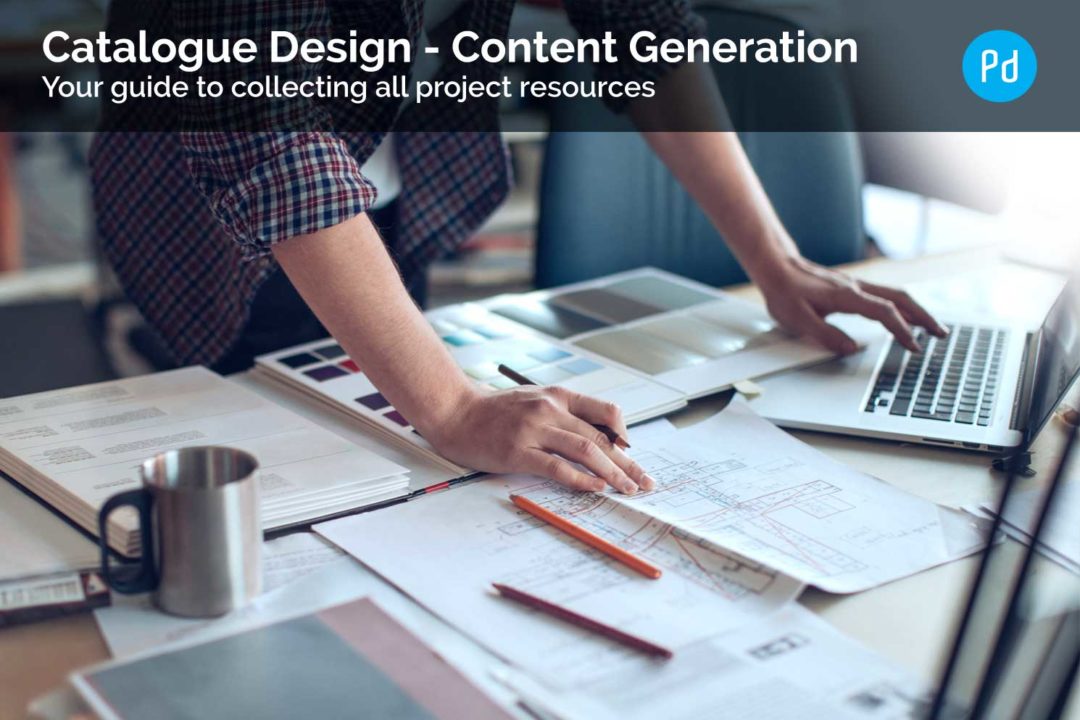It’s likely you have already started preparing content for your catalogue. This Catalogue Design Content Generation Guide gives clear recommendations and pointers to help pull everything together and make producing your catalogue a much smoother process.
Write a Contents List
The first thing to do is list the main categories or sections for your catalogue. Decide the sequential order which works best. You might choose to begin with your most popular or best selling product category at the front of your catalogue followed by the most closely related category next in order. Or you might simply choose to run through in alphabetical order to help readers find what they’re looking for more easily.
Prepare Sufficient Resources for Initial Design Concepts
Be sure to have sufficient resources available from the outset so your designer can make a start on initial design ideas. Provide sample content text, images, plus any charts or diagrams that need to be included. From the start, give your designer content for the most heavily populated pages. This content will be used to establish the final template and layout for your pages. It will determine the most suitable column structure and size of images. It will also dictate the optimum size for headings, sub-headings, body text bullet points, etc. Read more about what you should expect to see from your designer at the catalogue design concepts stage.
While your designer is working on the initial design concepts, use this time to prepare the remaining content for your catalogue.
Using your pre-prepared flat page plan as a guide collect and organise all your product information. Remember, as well as listing product features highlight the key benefits too. Think about your key business messages and selling points including guarantees, endorsements and accreditations. Collect customer testimonials as these will give added reassurance to your customers that other buyers have had a positive experience doing business with you.
Copywriting
Write clear, concise descriptions for all your products. Whether this is the first time you’ve ever produced a catalogue or if you’ve been through the whole process before, the content information has to be written either from scratch or existing content reviewed to check the details are factually correct and brought up to date.
Communicate your offering in a clear and concise manner. Good copy writing will be more successful at helping your readers understand exactly what you want to communicate about your products and services. The best is often done very simply with no jargon or long complicated language. Words must be written for the reader in mind, telling them what they need to know about your products. Your copy should also direct them take the next step to act on what you have to offer.
Product Images
Capture and select the best quality product images. Don’t be satisfied with second best. No matter what product or service you are selling, good quality, professionally captured photo images or illustrations will always increase the perceived value of your offering. This applies to application shots as well as product photos.
There’s nothing worse than a grainy, badly lit, pixelated or blurry images in any catalogue. It will do very little to convince your prospect to part with their money and buy from you. It’s better to have no image at all than have a bad one.
Resist the temptation to photograph your products using your own digital camera such as the one on your mobile phone. Although this technology is improving all the time and it may be acceptable for some applications but inevitably, you will never get consistent results and this will be telling when you see your final catalogue when finished.
Professional Photography
Always seek to commission the services of a professional photographer with a commercial track record. Most will have a photo studio with all their camera equipment, backdrops or room sets where your products can be photographed. Many photographers would be prepared to come to your premises and bring along all their photographic and lighting equipment to shoot your products on-site.
Consistent lighting and camera angles will really help your catalogue pages look professional and make your products more desirable. Most catalogue designers would be happy to liaise with a photographer and provide the art direction necessary to capture images that will be perfectly suited for your catalogue.
Sometimes it may be necessary to re-touch, cut-out or colour correct your images to achieve the desired outcome. Be sure to check with either your photographer or designer if this post-processing work will have any impact on production time and costs.
If you’re not able to capture the images you want using photography consider other ways to visualise your products. For example, illustrations, 3D models, diagrams or simple infographics. Your designer can help to suggest alternative, suitable options. However, please allow added time and budget for more complex image capturing.
File Naming
Your designer will ask you to supply the assets and resources in various formats. Here are the most common examples;
– Logo files = EPS (preferably in vector format)
– Text files = .TXT or .DOC or .XLS
– Image files = .JPG or .TIFF or .PSD
It’s vital that you organise and give identifiable names to all your image files. Use actual product names or SKU codes where possible. This will prove to be an invaluable exercise when it comes to locating and matching images to product descriptions. This will prevent artwork errors and save your designer a great deal of time too.
File Sharing
Producing a product catalogue tends to generate a vast amount of electronic resource files that all need to be brought together by your designer to create your page layouts and print-ready artwork. Put in place an efficient process to deliver all your electronic resource files to your designer.
The most reliable and easy to use online systems are Dropbox and WeTransfer. Both offer free to use services. Unlike attaching files to an email your files are uploaded to the Cloud meaning you only need to send a link to your designer enabling them to download your files. This process will save you time and cost of copying files to CDs or USB flash drives which would have to be sent physically by post or handed over in person.
Need more help with your catalogue?
Here are a few more related, very useful articles which are a must read…
Planning Guide for Catalogue Design
Catalogue Design Concepts – What to Expect From Your Designer
Artwork and Proofing Guide for Designing Catalogues
Remember to download our free guide for step-by-step tips and advice on creating the perfect brief for your designer.
Want to find out more about the services we offer at Palmiero Design? Feel free to get in touch or request a quote. We look forward to hearing from you!
Professional catalogue designers ready to discuss your brief today. > Request a Quote Now


